Independence-class aircraft carrier
This article needs additional citations for verification. (January 2013) |
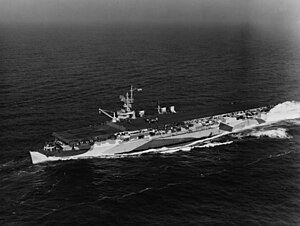 USS San Jacinto on a training cruise off the east coast in 1944
| |
| Class overview | |
|---|---|
| Builders | New York Shipbuilding |
| Operators | list error: <br /> list (help) |
| Succeeded by | Error: {{sclass}} invalid format code: 6. Should be 0–5, or blank (help) |
| Completed | 9 |
| Lost | 1 |
| Retired | 8 |
| Preserved | 0 |
| General characteristics | |
| Type | Light aircraft carrier |
| Displacement | 11,000 tons (standard) |
| Length | 622 ft 6 in (190 m) |
| Beam |
|
| Propulsion |
|
| Speed | 31.5 knot (58 km/h) maximum |
| Aircraft carried | list error: mixed text and list (help) Typical operational complement as of October 1944:
|
The Independence class aircraft carriers were a class of light carriers built for the United States Navy that served during World War II.
This class of ship were constructed as a result of the interest of President Franklin D. Roosevelt. With war looming, the former Secretary of the Navy noted no new fleet aircraft carriers were expected to be completed before 1944.[1] He proposed to convert some of the many cruisers then under construction to carriers. Studies of cruiser-size aircraft carriers had shown the type had serious limitations, and on October 13, 1941, the General Board of the United States Navy replied that such a conversion showed too many compromises to be effective. Undeterred, President Roosevelt ordered another study. On Oct 25th a second study from BuShips reported that the cruiser conversion aircraft carrier would result in a vessel of lesser capability, but they would be available much sooner.[2] Following the December 1941 Pearl Harbor attack the need for more carriers became urgent. In January 1942 The Navy responded by greatly accelerating construction of the 34,000 ton Essex class aircraft carriers, and ordering the conversion of a Cleveland class light cruiser then under construction to completion as a light aircraft carrier.
Development
Plans developed for this conversion showed much more promise than expected. The design was based on the Sangamon class escort carrier[3] and two more light cruisers were reordered as carriers in February, three in March and a final three in June 1942. The Independence class design featured a relatively short and narrow flight deck and hangar, with a small island. The hanger, flight deck and island represented a significant increase in the ship's topside weight. To compensate for this blisters were added to the original cruiser hull, which increased the original beam by five feet. The vessel carried a small air group of about 30 aircraft, originally intended to include nine each of fighters, scout-bombers and torpedo planes, but later reoriented to number about two dozen fighters and nine torpedo bombers.
These were limited-capability ships, whose principal virtue was near-term availability. Their limited size made for seakeeping difficulties in the many typhoons of the Pacific, and their small flight decks led to a relatively high aircraft accident rate. However, being based on a light cruiser, they were fast ships, much faster than the Casablanca class escort carriers. The cruiser hull and engineering allowed them the speed necessary to operate with the main fleet carrier task groups.
Service
Completed in the course of 1943, and coming into service with the first eight of the Essex class carriers, the nine Independence class ships made up a vital component of the Fast Carrier Task Force, which carried the Navy's offensive through the central and western Pacific from November 1943 through August 1945. Eight of these carriers participated in the Battle of the Philippine Sea in June 1944, which effectively ended Japan's carrier air power. The light carriers provided 40 percent of the Fast Carrier Task Force's fighters and 36 percent of the torpedo bombers. The protection on these carriers was modest, and munitions often had to be stowed at the hangar level, a factor that contributed greatly to the loss of Princeton in October 1944.
Ships in class
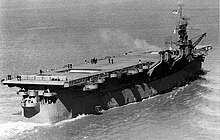
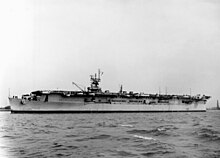
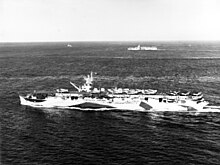
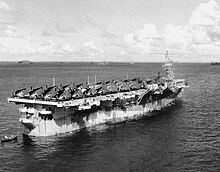
The nine ships of the Independence-class were all converted from Cleveland-class light cruisers building at the New York Shipbuilding Corporation shipyard, Camden, New Jersey. Initially classified as "aircraft carriers" (CV), all were re-designated "small aircraft carriers" (CVL) on 15 July 1943, while four ships were still under construction.
- Independence (CV/CVL-22). Keel laid in May 1941 as Amsterdam (CL-59); reclassified as an aircraft carrier in January 1942; launched in August 1942; commissioned in January 1943. Postwar, she was surplus to the Navy's requirements and expended in Operation Crossroads in July 1946, but survived both tests with little damage. She was used as a radiation research hulk for several years afterward and expended as a target in January 1951.
- Princeton (CV/CVL-23). Keel laid in June 1941 as Tallahassee (CL-61); reclassified as an aircraft carrier in February 1942; launched in October 1942; commissioned in February 1943. Destroyed as a result of Japanese air attack 24 October 1944 during Battle of Leyte Gulf.
- Belleau Wood (CV/CVL-24). Keel laid in August 1941 as New Haven (CL-76); reclassified as an aircraft carrier in February 1942; launched in December 1942; commissioned in March 1943. Decommissioned to reserve in January, 1947. Transferred to French Navy as Bois Belleau (R97) 6/51. Returned to the US Navy for scrapping 9/60.
- Cowpens (CV/CVL-25). Keel laid in November 1941 as Huntington (CL-77); reclassified as an aircraft carrier in March 1942; launched in January 1943; commissioned in May 1943. Decommissioned to reserve in January, 1947. Stricken and scrapped starting November 1959.
- Monterey (CV/CVL-26). Keel laid in December 1941 as Dayton (CL-78); reclassified as an aircraft carrier in March 1942; launched in February 1943; commissioned in June 1943. Decommissioned to reserve February 1947. Recommissioned as training carrier September 1950, decommissioned to reserve again January 1956. Re-designated aircraft transport AVT-2 May 1959. Stricken June 1970.
- Langley (CVL-27). Originally planned as Fargo (CL-85); reclassified as an aircraft carrier in March 1942; keel laid in April 1942; name changed from Crown Point to Langley in November 1942; launched in May 1943; commissioned in August 1943. Decommissioned to reserve February 1947. Transferred to France as La Fayette (R96) 2 June 1951. Returned to USN and stricken March 1963, scrapped at Baltimore in 1964.
- Cabot (CVL-28). Keel laid in March 1942 as Wilmington (CL-79); reclassified as an aircraft carrier in June 1942; launched in April 1943; commissioned in July 1943. Decommissioned to reserve February 1947, recommissioned and modernised as ASW carrier October 1948. Decommissioned to reserve January 1955, modernised 1965-7 and transferred to Spain as Dedalo (R01) 30 August 1967. Stricken from NVR and sold to Spain August 1972. Decommissioned for preservation at New Orleans August 1989, preservation efforts failed. Scrapped at Brownsville, Texas starting October 2000.
- Bataan (CVL-29). Originally planned as Buffalo (CL-99); reclassified as an aircraft carrier in June 1942; keel laid in August 1942; launched in August 1943; commissioned in November 1943. Decommissioned to reserve February 1947, recommissioned and modernised as ASW carrier May 1950. Decommissioned to reserve April 1954. Stricken for scrapping September 1959.
- San Jacinto (CVL-30). Originally planned as Newark (CL-100); reclassified as an aircraft carrier in June 1942; keel laid in October 1942; name changed from Reprisal to San Jacinto in January 1943; launched in September 1943; commissioned in December 1943. Decommissioned to reserve March 1947. Stricken June 1970.
Disposal
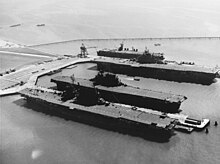
There was little margin for growth, as the ships' post-war careers showed. Independence was expended as an atomic bomb target, and the rest were laid up in 1947. Five returned to service in 1948–53, two with the French Navy. Two were used as training carriers, while Bataan saw Korean War combat duty with Marine Corps air groups. She and Cabot received anti-submarine warfare modernisations in the early 1950s, emerging with two funnels instead of the original four. All but the French ships were decommissioned in 1954–56 and were reclassified as aircraft transports in 1959. Cabot got a new lease on life in 1967, when she became the Spanish Navy's carrier Dedalo, serving until 1989 (in Spanish service, she was the first carrier to regularly deploy the Harrier jump jet). Despite best efforts to preserve her, Cabot was scrapped at Brownsville, TX starting in 1999 and ending in 2003. Preservation efforts continued until the hull was half scrapped.
See also
![]() Media related to Independence class aircraft carrier at Wikimedia Commons
Media related to Independence class aircraft carrier at Wikimedia Commons
References
- ^ Friedman, Norman U.S. Aircraft Carriers United States Naval Institute (1983) ISBN 0-87021-739-9 pp.412&413
- ^ Friedman, p.182
- ^ Friedman, p.182
